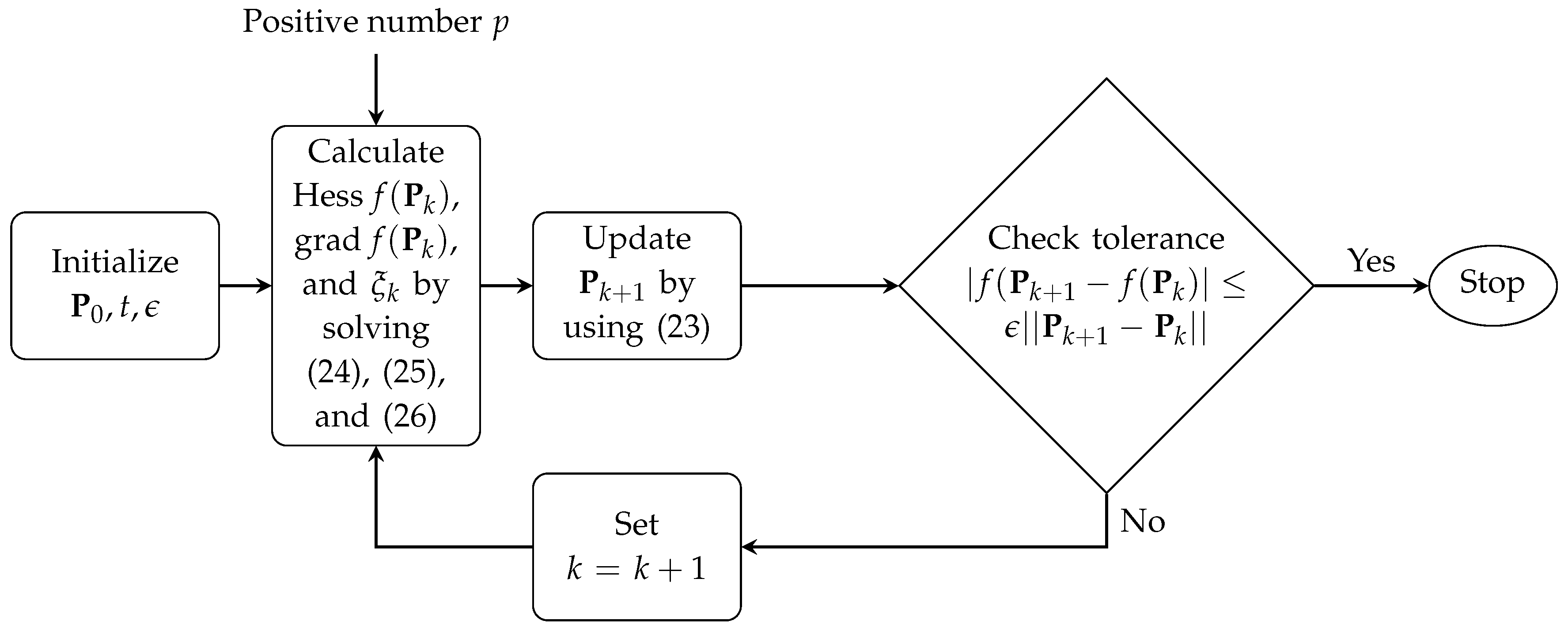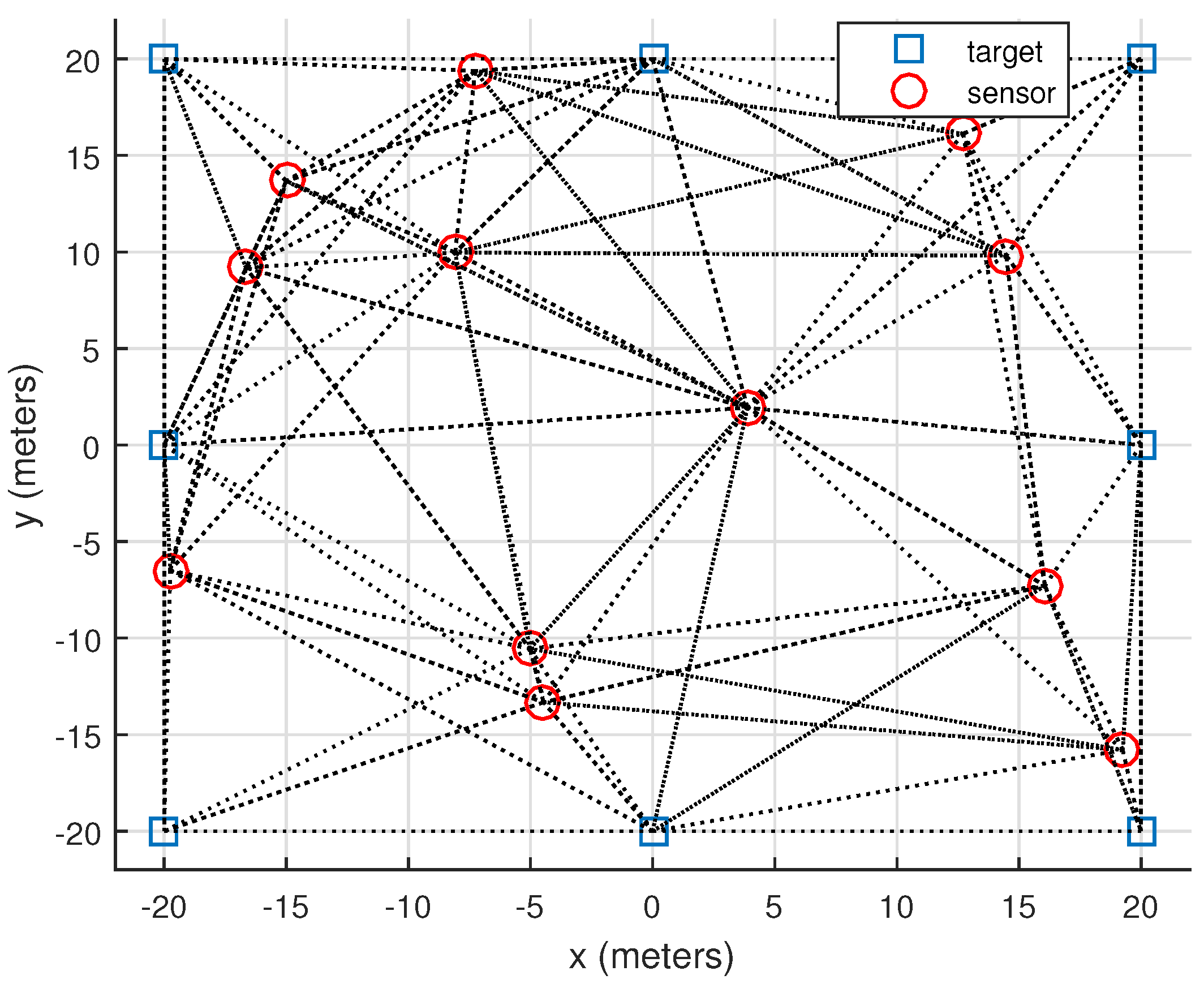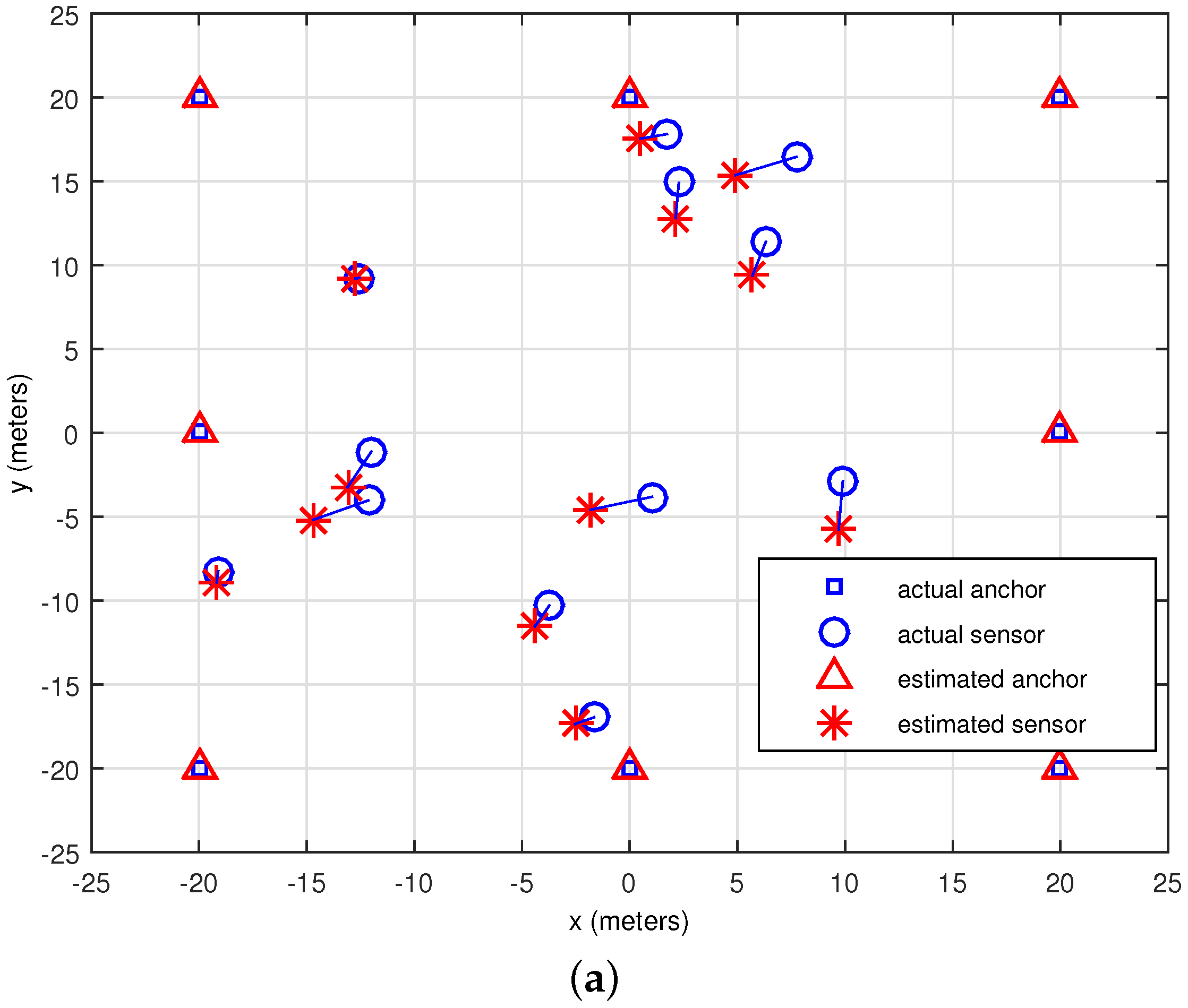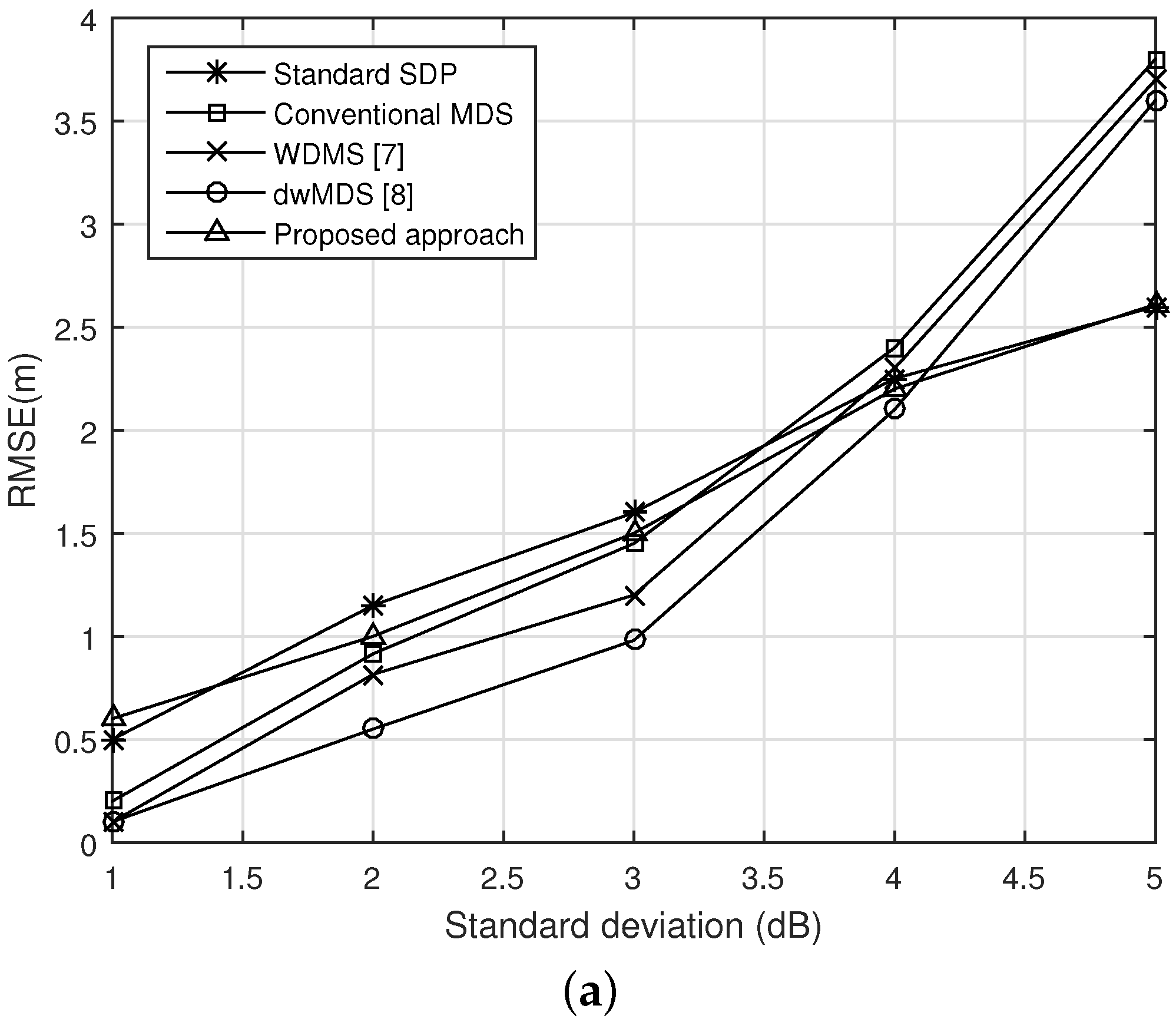2. Problem Formulation of Sensor Network Localization
Consider a sensor network consisting of
n wireless sensors at the locations
, where
r is the embedding dimension. As defined in the previous section,
represents the Euclidean distances between sensors within given radio range
R. The embedding dimension is the smallest integer
r satisfying
We denote the locations of
m known anchor nodes as
. Let
, and
represents the unknown sensor nodes. In the sensor network localization problems, we ignore the distinction between the anchors and the other sensors, hence we identify
with
and set
We also assume that there are a sufficient number of anchors, which makes our problem not be realized in a smaller embedding dimension.
Denoting the distance between the unknown node
i and the anchor
j as
, the corresponding RSS measurement can be expressed according to the following radio propagation path loss model in dB’s [
13].
where
is the path loss,
is the transmission power,
denotes the path loss value at the reference distance
,
γ is the path loss exponent, and
is a Gaussian random variable representing the log-normal shadowing effect,
. The distance
can be computed through the RSS measurement by the maximum likelihood (ML) estimation. Then, the corresponding ML estimator
is given by [
5]
Note that if we define
, where
e is the Euler’s number, then
. The Equation (
12) can be rewritten as
By using the Gaussian moment generating function, we can derive
which shows that the estimator is biased. In order to obtain the unbiased estimator, we let
where
, which yields the following variance of
.
After obtaining the estimated distance
, we can apply the SDP estimator [
6] or its relaxation [
5,
14] to reconstruct the distance matrix
from the RSS measurements. By partitioning, the
Euclidean squared distance matrix can be expressed as follows.
where
is the
distance sub-matrix between the unknown locations,
is the distance sub-matrix between the anchor locations and the unknown locations, and
is the distance sub-matrix between the anchor locations.
However, since at any time an unknown node
i is only in the communication range of small subset of the anchor nodes, the matrix of RSS measurements is partially known. Thus, the matrix
in Equation (
8) is incomplete and is affected by noises,
i.e.,
. Our goal is to reconstruct the complete distance matrix
from the RSS measurements. From this matrix, we can recover the unknown node locations. The problem formulation is briefly described as follows. Given
and
distance matrix
with corresponding adjacency matrix
, we need to solve
3. Main Results
The problem in Equation (
16) cannot be solved easily due to its non-convex nature and high computational complexity. Then, we try to reformulate it into another form without leaving the minimum. We suppose that
satisfies
(centroid) and
. Based on the fact that any rank-
r positive semidefinite matrix admits a factorization
[
11], we rewrite Equation (
16) as
For simplicity, let
, and
. Therefore, we denote the objective function as
Following Equation (
5), we have
where
. This problem is now reformulated as an constrained optimization for the cost function Equation (
18), which can be solved efficiently by using the Newton’s method [
15,
16,
17]. One of the motivations behind this method for optimization is to describe it as a sequence of second-order Taylor expansions and minimization.
where
. The iteration that computes an approximate solution to the system of equations
, is updated as
In practice, one does not compute
by explicitly computing
and then multiplying by
, since it is computationally inefficient. Instead, it is more practical to solve the system of linear equations
for unknown
. There are also many approaches such as matrix decompositions or other algebra techniques [
18] in calculating
to reduce its complexity when computing matrix operators. In general, the Newton’s method will find the minimum in one iteration and has extremely fast convergence, if
is positive definite at the minimum and the initial guess for
is close enough to this point. However, in some cases it may return any critical points of
f, that is, minima, maxima, or saddle points. To avoid these situations, we make some modifications to the Newton’s method, so that it finds the critical points which are actually the minima.
For search direction, we perform a line search,
i.e., for each iteration we solve Equation (
22) and update
where
t is small enough to get fast convergence. It can be
or
for some special cases [
19].
It is also necessary to find an effective method to solve Equation (
22). The Cholesky factorization is one of standard effective methods for solving linear systems compared to the Gaussian elimination or the LU decomposition. Note that any symmetric and positive definite matrix
can be expressed as
for some unit lower triangular matrix
and diagonal matrix
Σ with positive entries on the diagonal. For each step, we decompose
as
, then solve the following three sub-equations.
so that
, and
. However, when
is not positive definite, a Cholesky decomposition cannot be performed since its eigenvalues are sometimes very small negative numbers caused by rounding in computing and noise in the data. To overcome this kind of problems, we define a positive integer number
p to avoid the computation error by replacing
by
p when
is non-positive definite, and continue the factorization. If the absolute value of
is small or
is close to
, then we terminate
as the minimum, otherwise we continue the iteration. We always wish to construct
with the convergence to the minimum at a rapid rate, so that few iterations are needed until the stopping criterion is satisfied. However, this has to be counterbalanced with the computation cost per iteration because of the trade-off between fast convergence and higher computational cost per iteration.
In Equation (
17), we can discard the constraint
during the computational process. The reason is explained as follows. Let us assume that
is partitioned as
where
and
. Since
, we have
. If
, it imples that
,
i.e., there exists an orthogonal transformation
satisfying
. It was well-known as the ProCrustes problem [
4]. Hence, the problem Equation (
17) becomes an unconstrained optimization and it can be solve efficiently by the modified Newton’s method. However, the equality constraint
reduces the flexibility of
and can help the convergence to the global minimum in some cases.
In summary, we use the following procedures to solve the localization problem Equation (
17) as illustrated in
Figure 1.
Remark 1. The modification of the Newton’s method is illustrated by the solution path on the function in [19], which is able to follow the shape of the U-valley and converges to the minimum using only finite difference gradients. For the deployment of other adaptive methods for the mesh refinement or the discrete Newton-like method, we will consider these methods as well as their convergence issues in the future work. Remark 2. It has been shown that the conventional MDS has the time complexity of , while the WMDS [7] performed well for sparse networks but it is about two orders of magnitude slower than the MDS for larger networks (more than 100 node-networks). This is because the refinement strategy in [7] leads to a tradeoff between solution quality and computation cost. For the dwMDS algorithm [8], the authors proved that it takes time, where L is the number of iterations required until the stopping rule is satisfied, is the threshold distance, and depends on in a nonlinear way. A drawback of the dwMDS is that complexity, convergence time and initial estimate requirements for each transmission time depend sensitively on heavy weights and range measurement accuracy. For our approach, it can be verified that the computing for matrix decomposition takes , where , thus the total cost can be computed as , where K is the number of iterations. Thus, our approach compares favorably to the conventional methods in terms of the complexity. 4. Numerical Evaluation
In this section, the effectiveness of the proposed localization approach based on the modified Newton’s method is numerically investigated. Moreover, its location estimator is employed and compared. We consider a WSN consisting of 20 nodes placed in an area
m
with 8 of them are anchors and its geometry is illustrated in
Figure 2,
i.e.,
and
. The anchor locations are (20,20), (−20, −20), (20, 0), (−20, 0), (20, −20), (20, −20), (0, 20), (0, −20). The unknown sensor locations are randomly placed in this area. The maximum communication range between the nodes is set to be 25 meters. For the parameters in the path loss model of Equation (
10),
dB,
meter and
for
. We define the root mean square error (RMSE) by
In the first experiment, we investigate the performance of the proposed algorithm as shown in
Figure 3. It shows the effectiveness of the location estimation of our proposed scheme for a single trial with
dB [
13] in two cases: (a) presence of anchor locations and (b) absence of anchor locations. By “presence of anchor locations”, we mean that these locations are used in the initial guess for
, and inverse for “absence of anchor locations” case. A maximum RMSEs of
meter and
meter are observed over 100 simulations in
Figure 3a,b, respectively. It indicates that better initial points leads to better final results for our proposed scheme.
For the purpose of comparison, the RMSEs of our scheme and several schemes
versus σ are shown in
Figure 4. Each result is collected after 1000 independent runs. After obtaining the distance information in Equation (
12), we get the standard SDP estimator (SDP is used in the context of linear matrix inequalities and can be efficiently solved by interior point methods, which has the complexity of
), here,
ϵ is a given solution precision) by using the CVX package [
18,
19]. From the figure, we observe that our solution achieve the solution that better than the conventional MDS, WMDS, and dwMDS methods when the noise is large, and quite comparable estimation accuracy with the standard SDP for a small value of
σ, since our solution depends on how good initial points are. It can be improved if we can choose a good parameter to set up.
Figure 4b give us such an example. However, note that in this particular simulation with MATLAB implementation, the proposed method is faster than the others in running time.
The results indicate that our scheme is more suitable for the case of limited anchor node information. This is a good property for some scenarios where anchor node positions are not available. Thus, the obtained solution can be provided as a good initial point for other fine localization algorithms.











